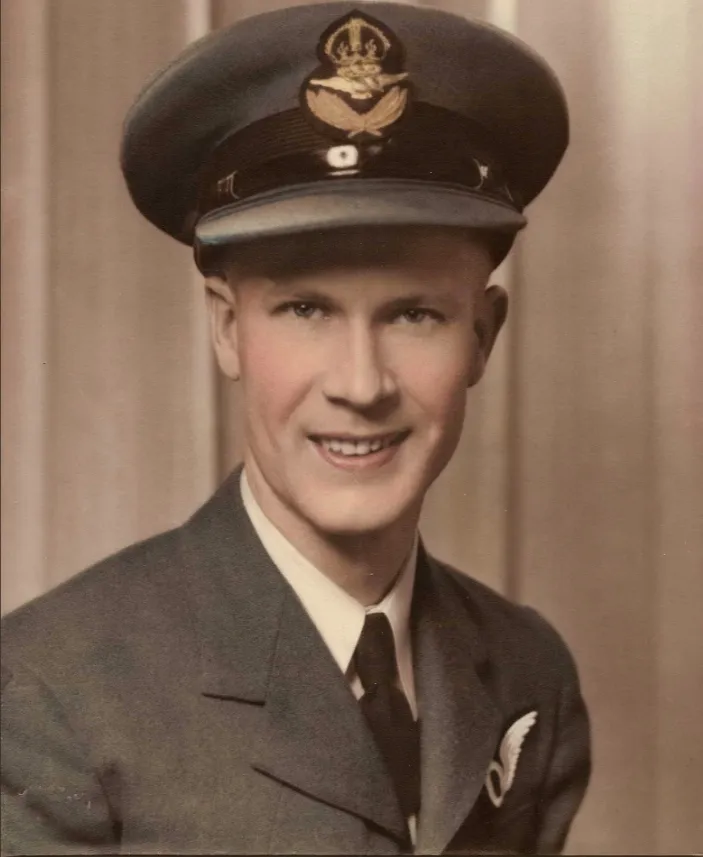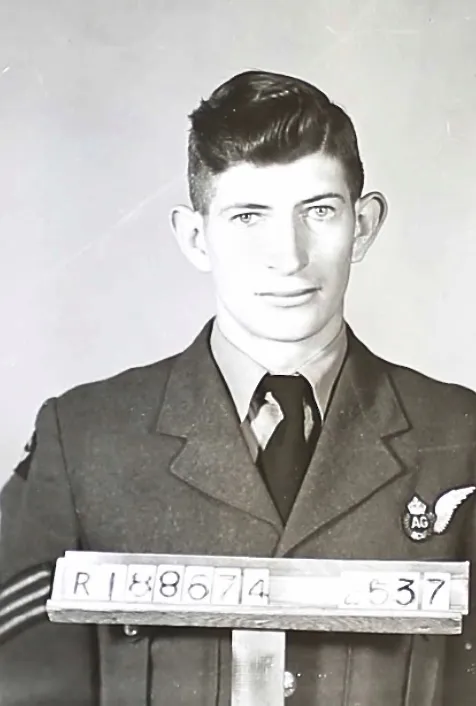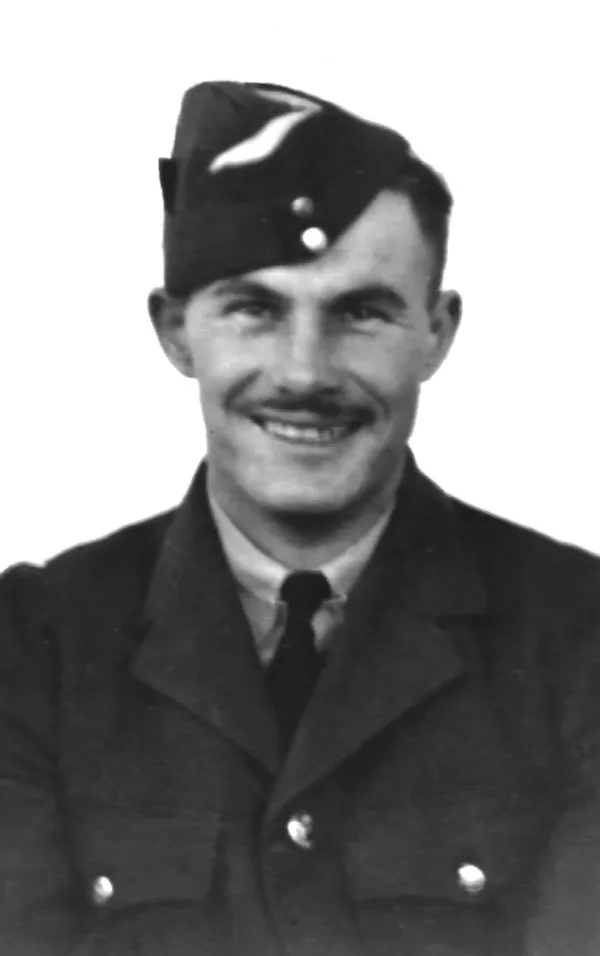426 Thunderbird Squadron (On Wings of Fire) RAF Linton-on Ouse. Lancaster BII aircraft DS 852 OW-P was shot down by a German night fighter, possibly by Schrage Musik* attack, during an operation to Nuremberg, Germany on March 31, 1944. It had flown north of the flight track on the outbound leg, was attacked, abandoned and crashed at Brotterode, Germany,
The Lancaster was one of 108 bombers lost or crashed on return to England, the largest Bomber Command loss of the war
Strong winds pushed a number of aircraft off target, several bombing Schweinfurt in error, 50 miles from Nuremberg. The problem as exacerbated by two Pathfinder aircraft dropping markers near Schweinfurt, Germany. Overall, the raid was a failure and little real damage was caused.
Pilot Officer SH Cullen (RCAF) and Pilot Officer HA Clark (RCAF) were killed in action
Flight Lieutenant EG Wey (RCAF)(injured), Flying Officer DT Stewart (RCAF), Sergeant HE Sjoquist (RCAF),Warrant Officer Class 2 RGS Douglass (RCAF) and Sergeant HJV Vincent (RAF) survived and were taken as Prisoners of War
This was Flight Lieutenant Wey's 2nd operational flight
Flight Lieutenant Wey died of natural causes while a PoW in Stalag Luft 1 on March 03, 1945. He was buried at the Cemetery at Barth, Pomerania, Germany, exhumed and reburied at the Berlin (1939-1945) War Cemetery, Charlottenburg, Germany
There were two 426 Squadron Lancaster II aircraft lost on this night. Please see Orr, HF for information on Lancaster DS 840 OW-C
* Schrage Musik, upward firing cannon fitted through the top of the fuselage of a night fighter, allowing it to fly up under a target and fire straight up into the underbelly of the bomber
War Diary
Error in opcode: wardiaries
Crew or Other Personnel
Lancaster DS852
Lancaster serial: DS852

Canadian Warplane Heritage Museum
The Avro Lancaster is a British Second World War heavy bomber. It was designed and manufactured by Avro as a contemporary of the Handley Page Halifax, both bombers having been developed to the same specification, as well as the Short Stirling, all three aircraft being four-engined heavy bombers adopted by the Royal Air Force (RAF) during the same wartime era.
The Lancaster has its origins in the twin-engine Avro Manchester which had been developed during the late 1930s in response to the Air Ministry Specification P.13/36 for a capable medium bomber for "world-wide use". Originally developed as an evolution of the Manchester (which had proved troublesome in service and was retired in 1942), the Lancaster was designed by Roy Chadwick and powered by four Rolls-Royce Merlins and in one version, Bristol Hercules engines. It first saw service with RAF Bomber Command in 1942 and as the strategic bombing offensive over Europe gathered momentum, it was the main aircraft for the night-time bombing campaigns that followed. As increasing numbers of the type were produced, it became the principal heavy bomber used by the RAF, the Royal Canadian Air Force (RCAF) and squadrons from other Commonwealth and European countries serving within the RAF, overshadowing the Halifax and Stirling. Wikipedia
Unit Desciption
426 (B) Sqn On wings of fire ("Thunderbird")
History of the Squadron during World War II (Aircraft: Wellington III, Lancaster II, Halifax III, VII, Liberator VI, VIII:)
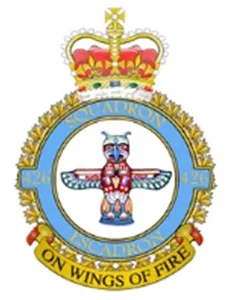
426 Squadron was formed at Dishforth, Yorkshire, UK ![]() on October 15, 1942 as the 24th RCAF squadron and seventh bomber squadron to be formed overseas in WWII. Originally it was a member of No 4 Group, RAF Bomber Command, flying Vickers Wellington Mk III aircraft with the squadron code OW as part of the strategic bombing of Germany. On January 1, 1943 it became part of No 6 (RCAF) Group, while remaining at Dishforth until June 1943. On June 17, 1943 it moved to Linton-on-Ouse, Yorkshire.
on October 15, 1942 as the 24th RCAF squadron and seventh bomber squadron to be formed overseas in WWII. Originally it was a member of No 4 Group, RAF Bomber Command, flying Vickers Wellington Mk III aircraft with the squadron code OW as part of the strategic bombing of Germany. On January 1, 1943 it became part of No 6 (RCAF) Group, while remaining at Dishforth until June 1943. On June 17, 1943 it moved to Linton-on-Ouse, Yorkshire. ![]() , as part of No 62 (RCAF) Base, at the same time re-equipping with Avro Lancaster Mk II aircraft. In April/May of 1944 , it again re-equipped, this time with Handley Page Halifax Mk III and VII aircraft, which it flew until the end of hostilities in Europe. At that time, to meet a need for long range transport in support of the proposed Tiger Force to attack Japan, it was re-designated as a Transport squadron in May 1945 and converted to Consolidated Liberator C Mk VI and VIII. After the surrender of Japan before the Tiger Force became operational, between October and December 1945 the squadron ferried troops from and around Egypt, India and the Far East. The squadron was disbanded at Tempsford, Bedfordshire, UK
, as part of No 62 (RCAF) Base, at the same time re-equipping with Avro Lancaster Mk II aircraft. In April/May of 1944 , it again re-equipped, this time with Handley Page Halifax Mk III and VII aircraft, which it flew until the end of hostilities in Europe. At that time, to meet a need for long range transport in support of the proposed Tiger Force to attack Japan, it was re-designated as a Transport squadron in May 1945 and converted to Consolidated Liberator C Mk VI and VIII. After the surrender of Japan before the Tiger Force became operational, between October and December 1945 the squadron ferried troops from and around Egypt, India and the Far East. The squadron was disbanded at Tempsford, Bedfordshire, UK ![]() on January 1, 1946.
on January 1, 1946.
Overall, the squadron flew 268 bombing missions involving 3233 individual sorties, for the loss of 88 aircraft. 8997 tons of bombs were dropped. There were 242 Transport sorties. The squadron members were awarded 2 DSO's, 130 DFC's and 2 Bars to DFC, 1 CGM, 25 DFM's1 DFC(USA) and 13 MiD's. [Possibly, the most heroic act realized by a member of the squadron during the war took place on October 20, 1943, when Flight Sergeant Stuart (the pilot) and his crew were sent to bomb Leipzig. During the mission he was engaged by enemy fighters, Messerschmitt Bf 109 and Junkers Ju 88, initially managing to shake them off but not before having his aircraft rendered almost unfit to fly, leaving it with shattered cockpits and gun turrets; holes in the fuel tanks, damaged hydraulics and no navigation instruments. Against all odds Stuart decided to continue the mission and successfully bombed his target before guiding his crippled aircraft home. He was awarded the Conspicuous Gallantry Medal.] Battle Honours were: English Channel and North Sea 1943, Baltic 1943, Fortress Europe 1943-44, France and Germany 1944-45, Biscay Ports 1943-44, Ruhr 1943-45, Berlin 1943-44, German Ports 1943-45, Normandy 1944, Rhine, Biscay 1943. Wikipedia, Moyes, Kostenuk and Griffin
Squadron History (Bomber Command Museum PDF)
Maps for Movements of 426 Squadron 1942-46
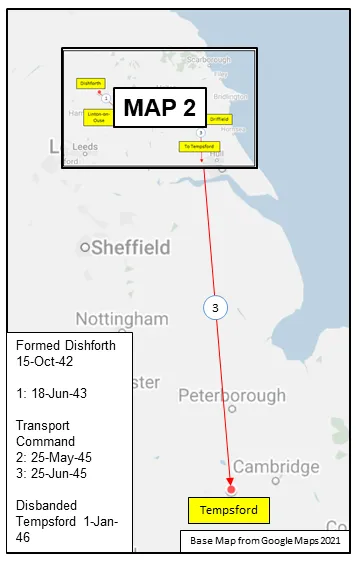
MAP 1: 426 Squadron Movements 1942-46 (right-click on image to display enlarged in new tab)
|
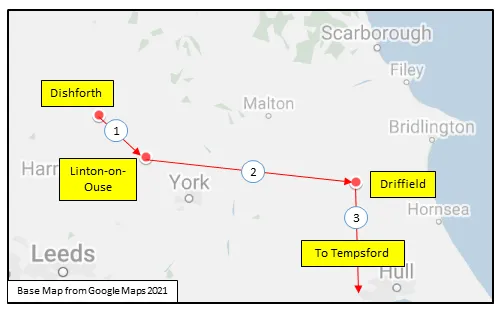
MAP 2: 426 Squadron Movements 1942-45 (detail of Map 1)
|
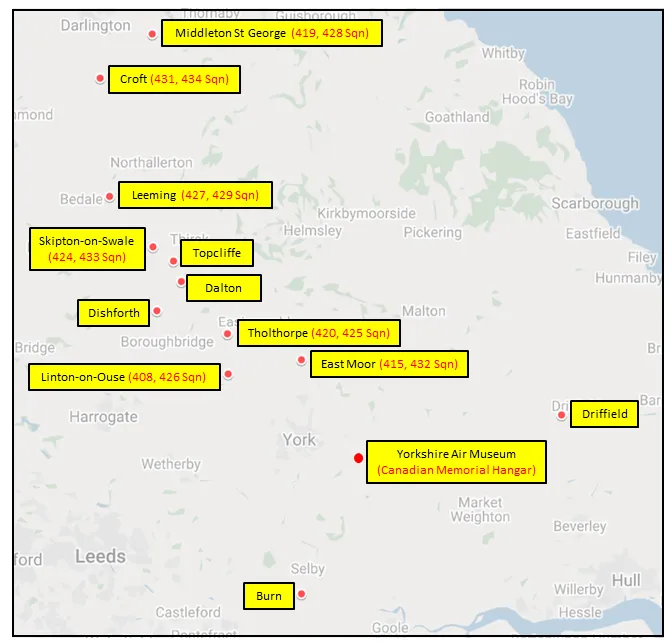
MAP 3: 6 Group Bomber Bases 1943-1945
|
426 Squadron History Summary 1942-46
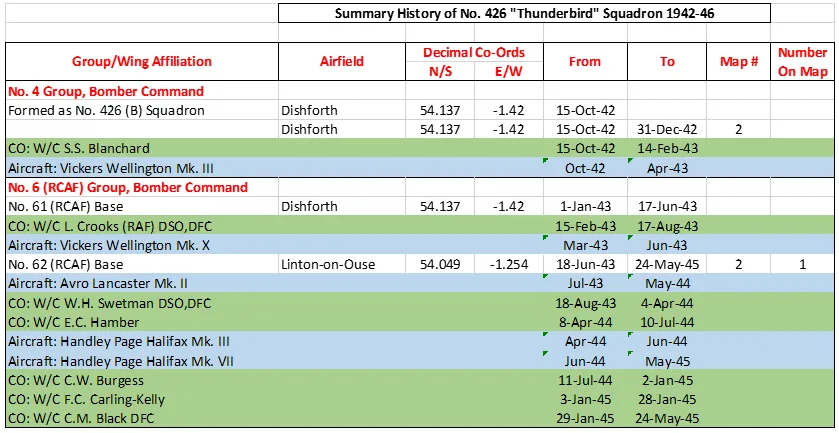
426 Squadron History Summary 1942-46 Page 2


History of the Squadron Post-WWII (Aircraft: Dakota, North Star, Yukon, Hercules)
The squadron was re-formed as a Transport unit at Dartmouth, Nova Scotia ![]() on 1 August 1946 from the Dartmouth portion of No. 164 (Transport) Squadron. It moved to Dorval (Montreal), Quebec
on 1 August 1946 from the Dartmouth portion of No. 164 (Transport) Squadron. It moved to Dorval (Montreal), Quebec ![]() in March 1947 and was re-equipped from Dakota to four-engine North Star aircraft for long-range transport duty. From July 1950 to June 1954 the squadron was detached to McChord Air Force Base in Washington, USA
in March 1947 and was re-equipped from Dakota to four-engine North Star aircraft for long-range transport duty. From July 1950 to June 1954 the squadron was detached to McChord Air Force Base in Washington, USA ![]() , from where it was employed on the Korean airlift (Operation “Hawkâ€) and made 600 round trips across the North Pacific between Vancouver and Tokyo, logging 34,000 flying hours and carrying 13,000 personnel and 7,000,000 pounds of freight and mail without mishap. A typical Korean Air Lift route for 426 Squadron aeroplanes was a physically and mentally demanding fifty-hour round trip flight from McChord to Japan and back with stops at Elmendorf Air Force Base (Alaska), Shemya (Aleutian Islands), Handed and Misawa Air Base (Japan). In 1956 it airlifted United Nations Emergency Force personnel and equipment to the Middle East and, in 1960-62, to the Belgian Congo. The unit moved to Trenton, Ontario
, from where it was employed on the Korean airlift (Operation “Hawkâ€) and made 600 round trips across the North Pacific between Vancouver and Tokyo, logging 34,000 flying hours and carrying 13,000 personnel and 7,000,000 pounds of freight and mail without mishap. A typical Korean Air Lift route for 426 Squadron aeroplanes was a physically and mentally demanding fifty-hour round trip flight from McChord to Japan and back with stops at Elmendorf Air Force Base (Alaska), Shemya (Aleutian Islands), Handed and Misawa Air Base (Japan). In 1956 it airlifted United Nations Emergency Force personnel and equipment to the Middle East and, in 1960-62, to the Belgian Congo. The unit moved to Trenton, Ontario ![]() in September 1959, and in January 1962 to St Hubert (Montreal) Quebec
in September 1959, and in January 1962 to St Hubert (Montreal) Quebec ![]() . The squadron was disbanded on 1 September 1962.
. The squadron was disbanded on 1 September 1962.
It reformed again as 426 Transport Training Squadron on May 3, 1971, at Uplands, Ontario ![]() . The squadron moved to Trenton in August 1971 where it remains today, conducting training on the CC-130 Hercules.The squadron has carried out many tasks since the end of Korean War, including casualty evacuations, Royal tours and other VIP transport, and United Nations air lift operations. Thunderbird has worked in many places: the Arctic, the Middle East and Europe, the Congo and Japan.
. The squadron moved to Trenton in August 1971 where it remains today, conducting training on the CC-130 Hercules.The squadron has carried out many tasks since the end of Korean War, including casualty evacuations, Royal tours and other VIP transport, and United Nations air lift operations. Thunderbird has worked in many places: the Arctic, the Middle East and Europe, the Congo and Japan.
426 Transport Training Squadron carries out classes of different courses every year to generate operationally effective air mobility aircrew and technicians in support of Canadian Armed Forces (CAF) operations. The squadron also has dedicated personnel assigned to provide operational test and evaluation and system support to Air Mobility fleets. In 1995, the Squadron’s school underwent extensive renovations and acquired state-of-the-art computerized training aids. In spring 2000, the Squadron completed an upgrade to its OFS-130H flight simulator. The changes included a new motion base, new visual system and upgraded avionics equipment. The Squadron also opened a new building housing the Cargo Compartment Trainer for the CC-130H Hercules. Anticipating the future needs of the Air Mobility community and the newly procured CC-130J Hercules, the school expanded its facilities in 2012. The Air Mobility Training Centre (AMTC) was designed and built to accommodate the latest in aircrew and technician simulation, making it one of the most advanced training facilities in the world. The building serves as the home of 426 Squadron staff, whose job it is to train and prepare aircrew, technicians and aeromedical personnel for employment on the CC-130J, CC-130H, and CC-150 Polaris aircraft. Wikipedia, Kostenuk & Griffin, and www.canada.ca/en/air-force/corporate/squadrons/426-squadron.html
Specifications
Click to open:
Avro Type 683 Lancaster
| General Characteristics | ||
| Crew: | 7 (typical) | |
| Length: | 69 ft 6 in (21.18 m) | |
| Wingspan: | 102 ft 0 in (31.09 m) | |
| Height: | 20 ft 6 in (6.25 m) | |
| Wing area: | 1,300 sq ft (120 m2) | |
| Aerofoil: | Root: NACA 23018. Tip: NACA 23012 | |
| Empty weight: | 36,900 lb (16,738 kg) | |
| Max takeoff weight: | 72,000 lb (32,657 kg) | |
| Fuel capacity: | 2,154 imp gal (9,792 L) | |
|
|
||
| Powerplants: |
Lancaster Mk.I, III, VI, VII & X:
|
|
|
|
||
| Propellers: |
Lancaster Mk.I, III, VI, VII & X:
|
|
| Performance: | ||
| Maximum speed: |
|
|
| Armament: | ||
| Standard: |
|
|
|
|
||
| Alternative/additional: |
|
|
|
|
||
| Bomb loads: |
Typical:
|
|
|
|
||
| Communication and navigation equipment: |
|
|
|
|
||
| Radio Countermeasures: |
|
|
Ventral Turrets
{{storedairimage,ventralturret.jpeg,float:right;width:400px;margin-left:10px;,Orginal Ventral Turret. Discontinued early.}}As originally designed the Lancaster was provided with ventral defence in the form of a Nash and Thompson FN64 turret, which was fitted to some early production aircraft. However, in common with all other periscope sighted ventral turrets, the narrow viewing angle made it almost impossible for gunners to acquire and track targets, and the few turrets which were installed were soon removed from service.
{{clearfloat}}{{storedairorigimage,Mod_925ventral50calMG-1.jpg,width:400px;,Original Drawings. Right click for larger view.}}
{{storedairimage,3 _W4766.jpg,width:400px;,W4766 from 61 Squadron}}
The ventral .50 inch (50 calib) was approved as Lanc Mod.925 during February 1944, and was one of a number of unsuccessful measures taken to counter night fighter attacks from below.
The growth of the Luftwaffe night fighter force was followed by an increase in the in the number of attacks from below, exacerbated from August 1943 onward by the introduction of aircraft equipped with Schrage Musik upward firing 20mm cannon. A number of responses were considered by Bomber Command including a free mounted ventral .50 calibre Browning machine gun, which was approved on the Lancaster as Modification 925 during February 1944.
The modification was very basic, consisting of little more than an enlarged bicycle seat for the gunner and a simple free mounted gun with open sights which fired through the ventral turret/H2S aperture. On aircraft with bulged bomb doors the mounting (often unpainted) was incorporated into the fairing at the rear of the doors.
Non-H2S fitted aircraft were sporadically equipped with the gun from February 1944 onward, although a clear plan for installation appears to have been lacking. The quantity of aircraft which actually had the gun installed is unknown and photos of the mounting with a Browning actually installed are very rare.
Serious problems quickly became apparent, as noted in the following V Group monthly newsletter for April 1944:- "With the gunner strapped in his seat it is difficult to follow the gun round on the beam; it is difficult for the gunner to get his head down behind the sight as it tends to push the oxygen mask upwards on the gunners face; and also considerable vibration is experienced on the sight when the gun is fired."
These problems, plus the gradually more widespread introduction of H2S saw the gun fall out of use quite quickly, although it does appear to have been retained on some aircraft until war's end (most notably in 3 Group).
The quantity of aircraft which actually had the gun installed is unknown and photos of the mounting with a Browning actually installed are very rare.
{{clearfloat}} {{storedairorigimage,75SqnORBextractMarch1945.jpg,float:right;width:400px;margin-left:10px;,75 Squadron ORB March 1945}}Notice on these aircraft the extra position in the eight person crew of Mid-Under-Gunner.
Serial Groups
| Serial & Range (Clickable) | Count | Manufacturer | Location | Notes |
|---|---|---|---|---|
| L7527 - L7584 | 43 | Avro | Manchester UK | |
| R5482 - R5917 | 257 | Metropolitan-Vickers | Manchester UK | |
| W4102 - W5012 | 407 | Metropolitan-Vickers | Manchester UK | |
| BT308 - BT308 | 1 | Avro | Manchester UK | |
| DG595 - DG595 | 1 | Avro | Manchester UK | |
| DS601 - DS852 | 200 | Armstrong Whitworth | Coventry UK | |
| DT810 - DT810 | 1 | Avro | Manchester UK | |
| DV155 - DV407 | 200 | Metropolitan-Vickers | Manchester UK | |
| ED303 - ED999 | 537 | Avro | Manchester UK | |
| EE105 - EE202 | 83 | Avro | Manchester UK | |
| FM100 - FM229 | 130 | Victory Aircraft | Malton CA | |
| HK535 - HK806 | 200 | Vickers-Armstrongs | Castle Bromwich UK | |
| JA672 - JA981 | 156 | Avro | Manchester UK | |
| JB113 - JB748 | 394 | Avro | Manchester UK | |
| KB700 - KB999 | 300 | Victory Aircraft | Malton CA | |
| LL617 - LL977 | 291 | Armstrong Whitworth | Coventry UK | |
| LM100 - LM756 | 509 | Avro | Yeadon UK | |
| ME295 - ME868 | 450 | Avro | Yeadon UK | |
| ND324 - ND996 | 541 | Avro | Manchester UK | |
| NE112 - NE181 | 59 | Avro | Manchester UK | |
| NF906 - NF999 | 82 | Armstrong Whitworth | Coventry UK | |
| NG113 - NG503 | 318 | Armstrong Whitworth | Coventry UK | |
| NN694 - NN816 | 100 | Austin Motors | Longbridge UK | |
| NX548 - NX794 | 200 | Austin Motors | Longbridge UK | |
| PA158 - PA999 | 271 | Vickers-Armstrongs | Chester UK | |
| PB112 - PB998 | 691 | Avro | Manchester UK | |
| PD112 - PD444 | 228 | Metropolitan-Vickers | Manchester UK | |
| PP663 - PP792 | 100 | Vickers-Armstrongs | Castle Bromwich UK | |
| RA500 - RA806 | 121 | Metropolitan-Vickers | Manchester UK | |
| RE115 - RE226 | 87 | Avro | Yeadon UK | |
| RF120 - RF326 | 170 | Armstrong Whitworth | Coventry UK | |
| RT670 - RT699 | 30 | Austin Motors | Longbridge UK | |
| SW243 - SW377 | 118 | Metropolitan-Vickers | Manchester UK | |
| TW647 - TW929 | 90 | Armstrong Whitworth | Coventry UK | |
| TX263 - TX273 | 11 | Avro | Yeadon UK |
9280 Airport Road
Mount Hope, ON L0R 1W0
905-679-4183
